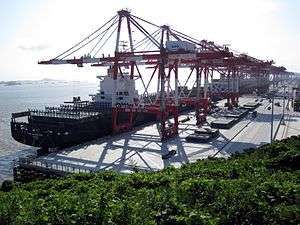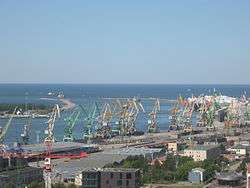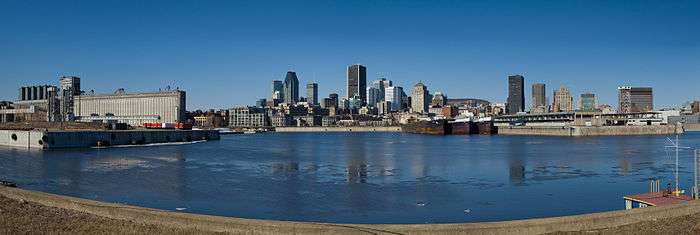Port


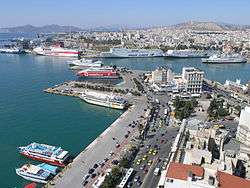




A port is a location on a coast or shore containing one or more harbors where ships can dock and transfer people or cargo to or from land. Port locations are selected to optimize access to land and navigable water, for commercial demand, and for shelter from wind and waves. Ports with deeper water are rarer, but can handle larger, more economical ships. Since ports throughout history handled every kind of traffic, support and storage facilities vary widely, may extend for miles, and dominate the local economy. Some ports have an important military role.
Historical
One of the world's oldest known artificial harbors is at Wadi al-Jarf on the Red Sea. Along with the finding of harbor structures, ancient anchors have also been found.
Ancient China
Guangzhou was an important port during the ancient times as far back as the Qin Dynasty.
Ancient Egypt
Canopus was the principal port in Egypt for Greek trade before the foundation of Alexandria.
Ancient Greece
Athens' port of Piraeus was the base for the Athenian fleet and this played a crucial role in the battle of Salamis against the Persians in 480 BC.
Ancient India
Lothal is one of the most prominent cities of the ancient Indus valley civilisation, located in the Bhāl region of the modern state of Gujarāt and dating from 3700 BCE.
Ancient Rome
Ostia Antica was the port of ancient Rome with Portus established by Claudius and enlarged by Trajan to supplement the nearby port of Ostia.
Japan
During the Edo period, the island of Dejima was the only open port for trade with Europe and only received one Dutch ship per year, whereas Osaka was the largest domestic port and the main trade hub for rice.
Distribution
Ports often have cargo-handling equipment, such as cranes (operated by longshoremen) and forklifts for use in loading ships, which may be provided by private interests or public bodies. Often, canneries or other processing facilities will be located nearby. Some ports feature canals, which allow ships further movement inland. Access to intermodal transportation, such as railroads and highways, is critical to a port, so that passengers and cargo can also move further inland beyond the port area. Ports with international traffic have customs facilities. Harbor pilots and tugboats may maneuver large ships in tight quarters when near docks.
Types
The terms "port" and "seaport" are used for different types of port facilities that handle ocean-going vessels, and river port is used for river traffic, such as barges and other shallow-draft vessels.
Inland port
An inland port is a port on a navigable lake, river (fluvial port), or canal with access to a sea or ocean, which therefore allows a ship to sail from the ocean inland to the port to load or unload its cargo. An example of this is the St. Lawrence Seaway which allows ships to travel from the Atlantic Ocean several thousand kilometers inland to Great Lakes ports like Duluth-Superior and Chicago.[1]
Fishing port
A fishing port is a port or harbor for landing and distributing fish. It may be a recreational facility, but it is usually commercial. A fishing port is the only port that depends on an ocean product, and depletion of fish may cause a fishing port to be uneconomical. In recent decades, regulations to save fishing stock may limit the use of a fishing port, perhaps effectively closing it.
Dry port
A dry port is an inland intermodal terminal directly connected by road or rail to a seaport and operating as a centre for the transshipment of sea cargo to inland destinations.[2]
Warm-water port
A warm-water port is one where the water does not freeze in wintertime. Because they are available year-round, warm-water ports can be of great geopolitical or economic interest. Such settlements as Dalian in China, Vostochny Port,[3] Murmansk and Petropavlovsk-Kamchatsky in Russia, Odessa in Ukraine, Kushiro in Japan and Valdez at the terminus of the Alaska Pipeline owe their very existence to being ice-free ports. The Baltic Sea and similar areas have ports available year-round thanks to icebreakers beginning in the 20th century, but earlier access problems prompted Russia to expand its territory to the Black Sea.
Seaport
A seaport is further categorized as a "cruise port" or a "cargo port". Additionally, "cruise ports" are also known as a "home port" or a "port of call". The "cargo port" is also further categorized into a "bulk" or "break bulk port" or as a "container port".
Cruise home port
A cruise home port is the port where cruise-ship passengers board (or embark) to start their cruise and disembark the cruise ship at the end of their cruise. It is also where the cruise ship's supplies are loaded for the cruise, which includes everything from fresh water and fuel to fruits, vegetables, champagne, and any other supplies needed for the cruise. "Cruise home ports" are a very busy place during the day the cruise ship is in port, because off-going passengers debark their baggage and on-coming passengers board the ship in addition to all the supplies being loaded. Currently, the Cruise Capital of the World is the Port of Miami, Florida, closely followed behind by Port Everglades, Florida and the Port of San Juan, Puerto Rico.
Port of call
A port of call is an intermediate stop for a ship on its sailing itinerary. At these ports, cargo ships may take on supplies or fuel, as well as unloading and loading cargo while cruise liners have passengers get on or off ship.
Cargo port
Cargo ports, on the other hand, are quite different from cruise ports, because each handles very different cargo, which has to be loaded and unloaded by very different mechanical means. The port may handle one particular type of cargo or it may handle numerous cargoes, such as grains, liquid fuels, liquid chemicals, wood, automobiles, etc. Such ports are known as the "bulk" or "break bulk ports". Those ports that handle containerized cargo are known as container ports. Most cargo ports handle all sorts of cargo, but some ports are very specific as to what cargo they handle. Additionally, the individual cargo ports are divided into different operating terminals which handle the different cargoes, and are operated by different companies, also known as terminal operators or stevedores.
Access
Ports sometimes fall out of use. Rye, East Sussex, was an important English port in the Middle Ages, but the coastline changed and it is now 2 miles (3.2 km) from the sea, while the ports of Ravenspurn and Dunwich have been lost to coastal erosion. Also in the United Kingdom, London, on the River Thames, was once an important international port, but changes in shipping methods, such as the use of containers and larger ships, put it at a disadvantage.
Environmental impact
There are several initiatives to decrease negative environmental impacts of ports. These include SIMPYC, the World Ports Climate Initiative, the African Green Port Initiative and EcoPorts.[4]
World's major ports
Africa
The busiest port in Africa is Port Said in Egypt.
Asia
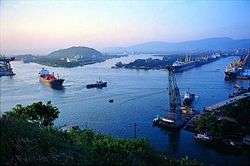
The port of Shanghai is the largest port in the world in both cargo tonnage and activity. It regained its position as the world's busiest port by cargo tonnage and the world's busiest container port in 2009 and 2010, respectively. It is followed by the ports of Singapore and Hong Kong, both of which are in Asia.
Europe
Europe's busiest container port and biggest port by cargo tonnage by far is the Port of Rotterdam, in the Netherlands. It is followed by the Belgian Port of Antwerp or the German Port of Hamburg, depending on which metric is used.[5] In turn, Valencia (Spain) is the busiest port in the Mediterranean basin.
North America
The largest ports include the ports of Los Angeles and South Louisiana in the U.S., Manzanillo in Mexico and Vancouver in Canada. Panama also has the Panama Canal that connects the Pacific and Atlantic Ocean, and is a key conduit for international trade.
Oceania
The largest port in Australia is the Port of Melbourne.
South America
The largest ports in South America are the Port of Santos in Brazil and Valparaíso in Chile.
See also
Water port topics
- Bandar (Persian word for "port" or "haven")
- Marina - port for recreational boating
- Port operator
- Ship transport
Other types of ports
Lists
- Lists of ports
- List of busiest cruise ports by passengers
- World's busiest port
- Sea rescue organisations
References
- ↑ "Seaway System". greatlakes-seaway.com.
- ↑ "Feasibility Study on the network operation of Hinterland Hubs (Dry Port Concept) to improve and modernise ports' connections to the hinterland and to improve networking" (PDF). InLoc. January 2007. Retrieved 2008-03-10.
- ↑ "Vostochny Port JSC, Geography, Location". Vostochny Port website. 2007. Retrieved 13 December 2012.
... Vostochny Port is located in the south of Primorsky Region, in the southeast of Nakhodka bay, in Vrangel bay. This is unique natural harbor is no ice restrictions even in severe winters. ...
- ↑ EOS magazine, 6,2012
- ↑ World Port Rankings 2011 (PDF)
External links
| Wikimedia Commons has media related to Ports and harbours. |
- Port Industry Statistics, American Association of Port Authorities
- Information on yachting facilities at 1,613 ports in 191 countries from Noonsite.com
- Social & Economic Benefits of PORTS from "NOAA Socioeconomics" website initiative
- Antunes, Cátia: Early Modern Ports, 1500-1750, European History Online, Mainz: Institute of European History, 2011, retrieved: November 2, 2011.
